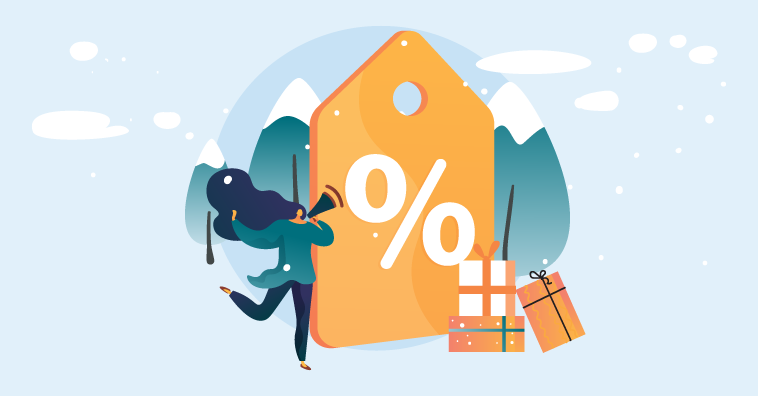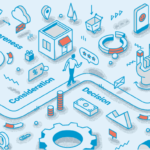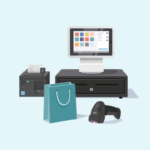Most retailers have a lot riding on the holiday shopping season. Overall, between October and December, retailers earn 27 percent of their annual revenues. But the last three months of the year matter even more to some types of retailers. Hobby and toy retailers count on the holiday season to generate 35 percent of their annual revenues. So do jewelry stores. And holiday shopping accounts for 31 percent of the year’s business for electronics retailers, 30 percent for clothing stores, and 28 percent for liquor retailers.
With a projected increase in holiday sales of up to 9 percent this year, how can retailers capitalize and make the most out of the holiday season? A strategic mix of holiday retail marketing promotions can end the year on a high note and set a retail business up for a strong year ahead. Here are five promotional strategies proven to build client relationships and drive sales for retailers during the busiest shopping season of the year.
1. Early bird deals
Supply chain challenges and shipping delays are prompting consumers to start shopping earlier. Nearly six in ten consumers plan to begin making holiday purchases during September and October, well before the traditional Black Friday date. Create early bird deals and discounts that encourage shoppers to purchase earlier in the season without waiting for deeper discounts later.
One way to get shoppers to purchase vs. browse early in the season is to guarantee them a price adjustment if you ultimately offer the item for less before December 24. This keeps customers from worrying they’ll miss out on a better deal down the road. Plus, they avoid the risk that you’ll run out of the item they want. Early bird deals are good for the retailer’s bottom line because you’re able to sell inventory earlier in the season without having to slash prices to avoid overstock situations down the line.
Related: Holiday Shopping Starts Now: A Preparation Checklist for Retailers
2. BOGOs and other “buy more, get more” offers
Who doesn’t love a good quantity discount? These types of offers appeal to consumers’ desire for a good deal – and they can have better margins for retailers compared to just cutting prices. Psychologically, offering merchandise as “buy one, get one” (BOGO) or “buy two, get the third item for 50 percent off” creates a sense of urgency for the customer and prompts them to purchase more than they may have originally intended. At the same time, they feel good about their savvy shopping. In fact, 66 percent of shoppers say they like BOGO the most out of potential discount options.
For retailers, BOGO offers can move inventory at good margins. Start by doing your homework. Set up and monitor regular inventory reports produced by your integrated point of sale (POS) system. This way, you’re able to identify items that would benefit from a BOGO offer while still maintaining profitability. For example, if you are selling an item for $20 that costs you $5, running a “half-off sale” would net a $5 profit for each item sold. However, if you opt to run a BOGO sale, you’d see a $10 profit ($20 in sales revenue – the $10 cost (2 items x $5) = $10).
3. Gift card extras
Gift cards are a highly popular gift option, second only to clothing and accessories and just ahead of toys in terms of popularity during the holiday season, according to the National Retail Federation. On average, each consumer purchases three to four gift cards as part of their holiday shopping. For retailers, gift cards represent a cash advance for future purchases where customers are more likely to pay full price – and spend an average of $59 more than the gift card’s value.
Boost consumer spending on your gift cards by offering an incentive. For example, when someone purchases gift cards worth $100 or more, give them an exclusive discount coupon or even an extra $15 gift card of their own. Leverage your POS system’s ability to track gift card purchases and usage to determine the appropriate threshold amount for providing gift card extras to the purchaser.
Related: 5 POS Promotions that Boost Retail Sales

4. Loyalty programs and perks
The holiday season is an ideal time to strengthen customer loyalty by ramping up your store’s loyalty program. Use a dual strategy focused on enrolling new customers and rewarding existing ones. After all, 84 percent of loyalty program participants say the program makes them more likely to return to a retailer, and 66 percent of shoppers acknowledge changing their spending behaviors because of a program’s rewards.
Encourage new customers to return by offering bonus rewards for joining your loyalty program. For example, provide a discount for their next purchase within a limited timeframe. And tap into your existing customer base by offering exclusive holiday season perks to loyalty program members such as coupons, early access to sales prices, or free shipping on online purchases.
Related: How to Create a Customer Loyalty Program that Works
5. Buy now pay later flexibility
Giving customers a range of payment options is also essential when competing for their holiday purchases and long-term loyalty. In fact, if a retailer doesn’t offer a customer’s preferred payment method, 42 percent don’t go through with the purchase. In addition to payment options, today’s shoppers value choices on when they pay. A buy now, pay later (BNPL) option enables a customer to make a purchase and pay for it at a later date or over a defined period. In many cases with BNPL, the customer doesn’t incur additional charges or fees as long as the payment terms are met.
BNPL is no longer just for high-dollar purchases. To date, 56 percent of consumers have opted for a BNPL option, which represents a significant spike from 38 percent in 2020. Among customers who haven’t yet taken advantage of the promotion, 53 percent say they’re likely to use it over the next year. Offering buy now, pay later options helps to bring in new customers and drive revenues. Retailers who offer BNPL show increased new customer rates up to 80 percent higher while reducing their return rates by 18 percent. With an integrated POS system in place, delivering and managing BNPL payments is easy for retailers. Choose POS systems with capabilities that streamline in-house accounts, payments on account, recurring billing, and finance charges.
POSIM is a point-of-sale and inventory management system designed to help you make the most out of your retail marketing promotional strategies during the holiday season and year-round. To explore what POSIM can do for your business, contact us for a demo.











